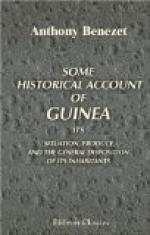The town of Leango stands in the midst of four Lordships, which abound in corn, fruit, &c. Here they make great quantities of cloth of divers kinds, very fine and curious; the inhabitants are seldom idle; they even make needle-work caps as they walk in the streets.
The slave trade is here principally managed by the Portugueze, who carry it far up into the inland countries. They are said to send off from these parts fifteen thousand slaves each year.
At Angola, about the 10th degree of South latitude, ends the trade for slaves.
CHAP. IV.
The antientest accounts of the Negroes is from the Nubian Geography, and the writings of Leo the African. Some account of those authors. The Arabians pass into Guinea. The innocency and simplicity of the natives. They are subdued by the Moors. Heli Ischia shakes off the Moorish yoke. The Portugueze make the first descent in Guinea. From whence they carry off some of the natives. More incursions of the like kind. The Portugueze erect the first fort at D’Elmina. They begin the slave trade. Cada Mosto’s testimony. Anderson’s account to the same purport. De la Casa’s concern for the relief of the oppressed Indians. Goes over into Spain to plead their cause. His speech before Charles the Fifth.
The most antient account we have of the country of the Negroes, particularly that part situate on and between the two great rivers of Senegal and Gambia, is from the writings of two antient authors, one an Arabian, and the other a Moor. The first[A] wrote in Arabic, about the twelfth century. His works, printed in that language at Rome, were afterwards translated into Latin, and printed at Paris, under the patronage of the famous Thuanus, chancellor of France, with the title of Geographica Nubiensis, containing an account or all the nations lying on the Senegal and Gambia. The other wrote by John Leo,[B] a Moor, born at Granada, in Spain, before the Moors were totally expelled from that kingdom. He resided in Africa; but being on a voyage from Tripoli to Tunis, was taken by some Italian Corsairs, who finding him possessed of several Arabian books, besides his own manuscripts, apprehended him to be a man of learning, and as such presented him to Pope Leo the Tenth. This Pope encouraging him, he embraced the Romish religion, and his description of Africa was published in Italian. From these writings we gather, that after the Mahometan religion had extended to the kingdom of Morocco, some of the promoters of it crossing the sandy desarts of Numidia, which separate that country from Guinea, found it inhabited by men, who, though under no regular government, and destitute of that knowledge the Arabians were favoured with, lived in content and peace. The first author particularly remarks, “That they never made war, or travelled abroad, but employed themselves in tending their herds, or labouring in the ground.”




